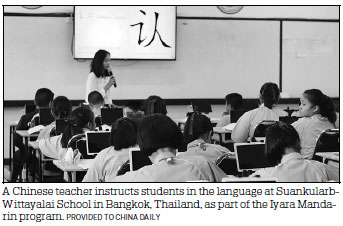Southeast Asia takes the lead in Chinese-language education
With demand rising for Chinese-language education in Southeast Asia, cooperation between Chinese and regional teaching institutions is expected to strengthen.
"The majority of overseas Chinese-language learners are from Southeast Asia. Chinese learners can be found in all kinds of industries and social groups of all ages," said Wu Yinghui, executive deputy dean and professor at the Research Institute of International Chinese Language Education at Beijing Language and Culture University.
Wu said more than 30 million Chinese live in Southeast Asia, accounting for about 6 percent of the region's population and over 70 percent of the Chinese population globally.
He said this has laid a solid foundation for Chinese-language education in the region, while closer cultural and economic ties between China and Southeast Asia have further increased interest in learning the language.
"Southeast Asia is taking the lead in Chinese-language education," said Wu, who is also a professor with the College of International Education at Minzu University of China in Beijing.
Throughout the region, various types of teaching methods are used, including instructing classes in Chinese and teaching it as a second foreign language.
For example, Wu said that in Malaysia, a comprehensive Chinese-language education system from kindergarten to college or university is in place. Thailand and Indonesia have also transitioned from prohibiting Chinese-language education to an open strategy. Confucius Institutes and volunteer Chinese-language teachers are also generally welcomed in the region.
Confucius Institutes are non-profit international public educational organizations that promote the Chinese language and culture, similar to the British Council in the United Kingdom, the Goethe Institut in Germany and Alliance Francaise in France.
Tan Chee Hiong, chairman of the Malaysia Mandarin Culture and Communication Association, a nonprofit organization that promotes Chinese-language education and culture in Southeast Asia, said Chinese has long been a major language for communication in Southeast Asia. Some countries, such as Malaysia, have established schools specifically for overseas Chinese.
In particular, Tan said the popularity of Chinese-language education is no longer limited to overseas Chinese, with demand rising among people from different origins.
"In Malaysia, for example, there are over 1,200 Chinese primary schools. In the past, over 90 percent of the students were of Chinese origin," Tan said. "But in recent years, the proportion of non-ethnic Chinese students has continued to increase and is expected to reach 18 percent this year.
"The rise of China on the world stage has prompted people from other ethnic groups to learn Chinese, as they think this will be beneficial for their future careers," he added.
The number of people learning Chinese overseas exceeds 160 million and is expected to reach 200 million by next year, according to a white paper jointly published by the Chinese Academy of Sciences and Lingo Bus, an online Chinese-language learning platform for children launched in 2017 by VIPKid, China's largest online education startup.
But Jiao Yu, founder of the Chinese-language education institution mmMandarin in Beijing, said the key to Chinese-language education should be the number of people reaching an intermediate or advanced level of proficiency and, to some degree, the number of those speaking the language fluently.
In May, mmMandarin launched a Chinese-language education program called Iyara Mandarin at Suankularb Wittayalai School, the oldest public secondary school in Thailand.
Ten out of 11 classes from the Bangkok school's first grade are studying Chinese under this program, according to Jiao. He said he hopes to expand it to other key secondary schools in Thailand and to work with them to help them train their own teachers.
Iyara Mandarin is an innovative curriculum that aims to help foreigners progress from being complete beginners to passing the HSK Level 5 within 520 hours. Jiao said the traditional study time required to reach this level of proficiency is about 2,000 hours or more.
HSK refers to the Chinese Proficiency Test, an international standardized exam to assess non-native Chinese speakers' ability in using Chinese. The test has six levels. Passing Level 5 means a candidate can read Chinese newspapers and magazines, understand Chinese films and plays, and give a full-length speech in Chinese, according to the Confucius Institute headquarters, the test organizer.
Wu, from Beijing Language and Culture University, said that with the launch of the China-led Belt and Road Initiative, economic and cultural cooperation between China and Southeast Asian countries will deepen and attract more people to learn Chinese.
Wu believes the development of Chinese-language education will accelerate when it is included in the national education systems of countries throughout Southeast Asia.
Tan, from the Malaysia Mandarin Culture and Communication Association, said, "The Chinese language is one of the main tools to demonstrate Chinese culture."
As people-to-people exchanges are a vital element of the BRI, Tan said he hopes China can further cooperate with regional countries on education, including building a more mature and comprehensive Chinese-language education system.

(China Daily Global 09/05/2019 page2)


















